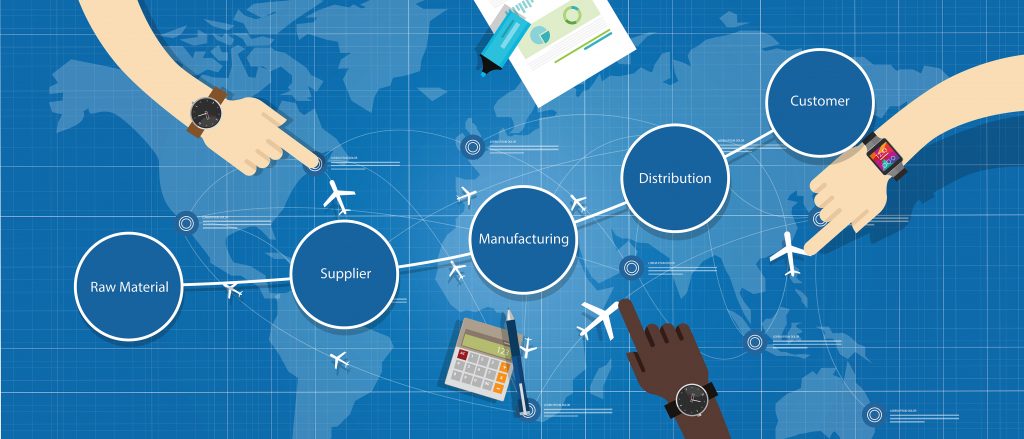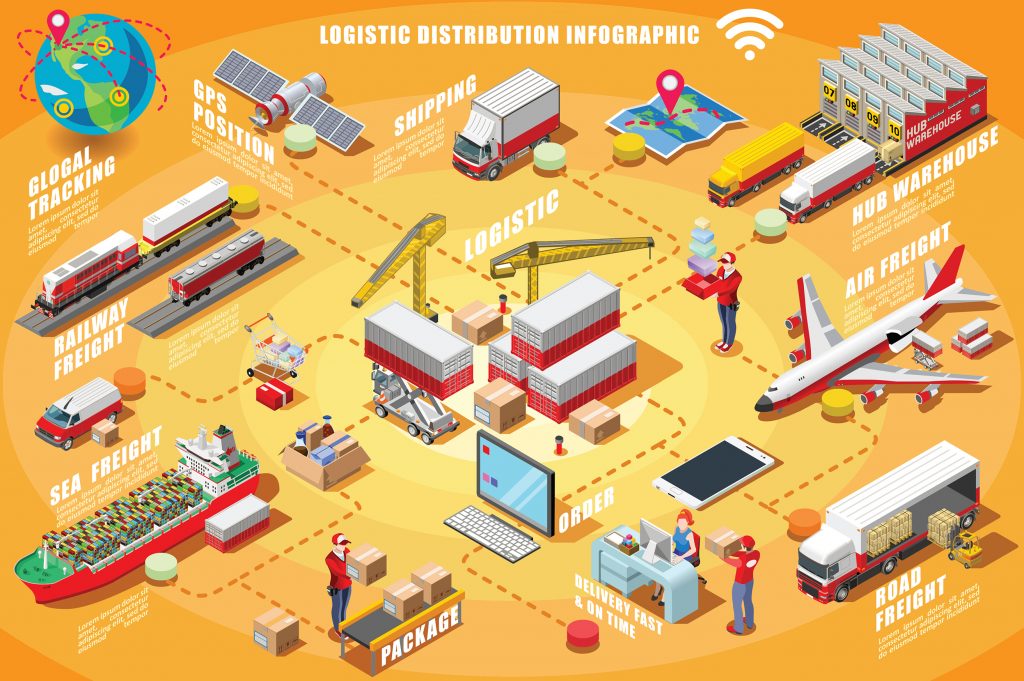
Supply Chain Disruption
By Rehana Begg
Operations TransportationThe pandemic’s effect on the supply chain ushers in a new period of decision-making.

Photo:© bakhtiarzein / Adobe Stock
Darrin Mitchell could see the writing on the wall. The effects of COVID-19 were shoring up in the early parts of 2020 and was on course to becoming the No. 1 supply chain vulnerability that would threaten his business.
Mitchell’s live-bottom trailer manufacturing business, Trout River Industries, was no different than the majority of manufacturing businesses expecting to be impacted by COVID-19. Like most CEOs, he balked as he watched borders lock down and witnessed social distancing and stay-at-home orders trigger the closure of non-essential businesses in hard-hit regions.
The normal course of business was already under pressure in February 2020. For one, rail lines were paralyzed by blockades erected in solidarity with Wet’suwet’en First Nation hereditary chiefs. That conflict stemmed from opposition to a natural gas pipeline in traditional territory in British Columbia. The impact of the protest rippled across the supply chain, affecting Mitchell’s company in Prince Edward Island.
“The rail lines closed, and we were watching our products being shipped via rail to the west coast of Canada,” said Mitchell. “Shipments were stopped in Saskatchewan.”
While the uncertainty about the duration and deepening effects of the coronavirus made clear why the pandemic was considered the dominant explanation for low trade numbers, the industry was reeling from a battery of local and global events. Oil prices plummeted and spending had slowed. Manufacturers were blindsided by non-traditional shifts in demand; some industries (pharma, food and paper goods) experienced up-swings due to stockpiling. Who could forget the knock-on effects of the closure of GM’s Ontario car assembly plant, the pipeline rupture in North Dakota, or how the biggest rail strike in a decade slowed down the movement of goods? Globally, the evolving trade and tariff situation with the U.S. (CUSMA), Brexit, geopolitical tensions with China, protectionism and political paralysis in the U.S. sent shockwaves through the supply chain.
Mitchell reacted with the only reasonable response: “Manage what you can manage.” That meant he would emphasize a few key measures he had installed over the years, and focus on what he could do in the moment that would also serve the business over the long haul.
Writing A Playbook
When Mitchell set up his trailer manufacturing business 22 years ago, he understood from the get-go that setting up an outfit in Coleman, a rural community in Prince County, P.E.I., would present unique logistical and supply chain challenges. His company would operate from the premise that “the likelihood of competing against companies that had hundreds of millions of dollars in capital investment would be slim,” he said. “We had to design a business model for manufacturing from the ground up, because we couldn’t compete against the companies in Ohio that were vertically and horizontally integrated.”
Since the reality of the remote location was a logistical challenge, Mitchell purposefully bolstered his company’s strengths by investing in a growth strategy that was hard to duplicate, such as the business brand, and licensing the company’s technology so it could foster growth and develop a global market. His efforts paid off; aside from the main facility on P.E.I., Trout River builds trailers in Western Canada, Europe, the Middle East, Japan and Australia.
The landscape changed once lockdowns started testing existing competencies and routines in the supplier infrastructure. Mitchell knew it was time to course correct.
“The challenge was in the leadership model of the business,” said Mitchell. “We had to be better at communication, we needed to have more meetings about min/max inventory systems, and more meetings about lead times. And yes, it was taxing.”
For one, suppliers and customers couldn’t visit the manufacturing plant. Neither could Mitchell check in with them.
“The convenience of hopping on a plane to check on a supplier was no longer an option,” he said.
The workaround was to build a Zoom studio for online meetings. “Now, I regularly meet with suppliers,” he said. “I was in six different countries in one day, meeting with my customers, and to just say, ‘Hi! What are your challenges?’ I need to know these things if we’re going to build a better relationship.”
While the uncertainty about the duration and deepening effects of the coronavirus made clear why the pandemic was considered the dominant explanation for low trade numbers, the industry was reeling from a battery of local and global events.
Mitchell acknowledged it was difficult to gauge the right action. Since paralysis was not an option, he developed his own playbook of move-forward tactics. The first tactic was to achieve end-to-end visibility so everyone in the organization could agree with min/max systems. Decisions, he said, should be grounded in good data and solid insights. In addition, Mitchell advised that everyone in the organization should know where the data comes from and what it means – from the leadership team to warehousing, and shipping/receiving, as well as your teams across the globe.
The second manoeuvre was to figure out how to use buffers to get out of firefighting mode. Measures that could standardize the supply chain, such as using visual indicators, would be helpful. At a tactical level, Mitchell had always championed the 75/25 per cent rule, whereby 75 per cent of purchases are repetitive, must-have, critical-to-quality items, and 25 per cent is reserved for add-on items.
“I worked very hard over the years with my procurement team, strategizing how we can visually standardize as much as 75 per cent of the work, and how we can keep higher paid, more insightful people worrying about the 25 per cent,” he said.
During the pandemic, Mitchell steered his team toward increasing inventory of critical components, as well as focusing on dual sourcing where needed. Moreover, he was able to track alternative suppliers’ inventory levels, and effectively harness buffers (stock/time/capacity) as a company’s strategic advantage.
“While some competitors were getting caught flat-footed, I actually took some of my buffer supply and started selling to my competition,” said Mitchell.
The third tactic was to evaluate supply chain relationships. Asking a few critical questions will help develop relationships with suppliers based on trust and innovation, said Mitchell. Consider, for example: when was the last time a supplier introduced a new product to the factory? When was the last time a supplier did training in the company? When was the last time a supplier offered to bundle a freight? Or, when was the last time the supplier put a shipment on with another client and delivered it at your factory to save $1,000 a month?
“If suppliers aren’t already doing these things, you may not have cultivated the right relationship,” said Mitchell. “If your supplier is merely driven on price, they ought not to be part of your supply chain over the long term.”
Finally, Mitchell’s fourth tactic was to speak to competitors. “If you think your systems are better than everybody else’s and your secrets are your secrets, they’re not,” said Mitchell. “Are you really doing something that nobody can figure out? Competitors are a great source of information when you’re stuck, as well as a potential partner.”

Photo:© Idanupong / Adobe Stock
Demand Shifts
To be sure, the pandemic tested ingenuity, flexibility and resilience, but also highlighted supply chain vulnerabilities that left manufacturers second-guessing their game plans.
Recognizing the signs, analysts and risk advisory teams raised the flag, signalling the need for manufacturers to focus on optimizing business continuity plans, managing cash flow, strengthening communications with stakeholders and enabling technology.
“Clients were impacted by supply chains adjusting,” said David Linton, Partner, BDO Consulting – National Manufacturing and Distribution Leader. “In our consulting group, we were spending a lot of time with clients, doing business continuity plans in case of closures of facilities.”
Linton pointed out that patterns of demand shifted during the pandemic. Since manufacturing subsectors were hit differently, solutions needed to be customized. “Business continuity plans and strategy are unique to each business,” said Linton, adding that risks in the supply chain could be addressed in many ways, including diversifying the supply base, looking at alternate sourcing options through near-shoring or onshoring, finding alternate materials that are good enough for substitute, or by designing a product in a different way.
On the supply side, inbound materials and packaging were impacted pretty early on, recalled Linton. On the other side, demand for some products dropped, but increased for others.
“We helped our clients pivot and looked after either the increase or the decrease on the sales side,” said Linton. “Some of that was with consumer demand increasing or decreasing. Some was government-driven by the need for PPE [personal protective equipment]. And some of it was the logistical challenges in the supply chain, resulting in either not being able to keep up with demand, or not being able to physically get the product to where it needed to be.”
That was the case for one of BDO’s clients, a manufacturer that produces equipment designed to rapidly recycle food waste. Owing to collective efforts to “flatten the curve” and save lives, the client’s target market – hospitality, restaurants, conference and event centres and cruise lines – took a nosedive last year.
“Their demand dropped dramatically,” said Linton. “It was not easy to pivot and start making different equipment for a different sector.”
The manufacturer was dramatically affected in the early months of the pandemic. However, Linton noted that signs of optimism are showing with the gradual opening of customers’ businesses and overall signs of recovery.

Photo: aurielaki/iStock / Getty Images Plus/Getty Images
Installing Guardrails
What happens next depends on whether Canadians are willing to learn from their experience. “I think the pandemic has been a wake-up call,” said Linton. He adds that Canadian manufacturers will learn two valuable lessons from the pandemic.
The first lesson is that in order to survive and thrive in the global economy, businesses have to invest in technology. The pandemic has accelerated technology adoption in manufacturing.
“Up until this point, Canadian manufacturers have lagged behind other countries in technology adoption,” said Linton, whose role at BDO includes helping clients improve their business through risk advisory management consulting and technology.
“Countries such as the U.S., Germany and other G7 countries have invested more in technology in manufacturing up until 2020/2021,” he said. “I wouldn’t necessarily regard it as a catch up, but we have certainly seen an acceleration in investment in technology.”
Canadian manufacturers rapidly adopted collaboration and productivity tools to allow remote/physically distanced working, such as Zoom, Teams, document sharing and scheduling tools. In addition, there has been a substantial amount of activity with Canadian manufacturers upgrading or rolling out e-commerce platforms for the first time. Analytics reporting and cash flow forecasting has become more prevalent.
“We’ve been doing a lot of work with modern and predictive analytics – machine learning (ML) or artificial intelligence (AI) – in an effort to look into the future of what the demand plan may be,” said Linton. “The 2021 federal budget allocated significant funding through various government bodies to increase the adoption of technology in manufacturing and other industries as well.”
The second lesson, said Linton, is that Canadian manufacturers will have learned that they need a business continuity plan, which includes minimizing disruptions in the supply chain as conditions change. Businesses will continue to find ways to gain an advantage by building and adjusting supply chain sources or looking for ways to reduce costs.
“At the end of the day, consumers drive business, and consumers will still demand lower cost,” said Linton. “If you’re a manufacturer supplying the retail sector, one of your competitive advantages will be lower cost. That’s what will help drive sales.”
Road to Resilience
Fourteen months into the pandemic, manufacturers are taking a fresh look at their supply networks and recognizing that a multitude of challenges remain. Would it be better to localize critical manufacturing and rebuild supply chains to avert scrambling for materials and rely less on risky countries? How will manufacturers make their supply chains more resilient without diminishing competitiveness? How can manufacturers avoid costly shut downs in the face of another disruption?
The definitive answer to these questions is: “It depends.” Given the interconnectedness of the global economy, the pandemic’s knock-on effects will have implications for all tiers of the supply chain. Both Linton and Mitchell agree that there is no one-size-fits-all solution. But there is room for optimism.
“Canadian manufacturers are resilient,” said Linton. “Many of them pivoted, found ways to keep their business going, and looked at the pandemic as an opportunity as well as a threat to their business.”
Coming out of the pandemic requires companies to look at vulnerabilities that could expose them. The details may also reveal opportunities. For Mitchell, leveraging the untapped potential in the supply chain has meant being creative at opening doors and uncovering different ways to do business. In October 2020, Mitchell made a life-altering move; he handed over the reins of his share of Trout River Industries to DLH Group. It was an offer he couldn’t refuse, he said.
“Ironically, the pandemic may help Canadian manufacturing in the long term,” said Linton. “Canadian manufacturing in five years will be stronger, better for the pandemic. That may sound counterintuitive, but that is the main learning I’ve had from this.”
________________
Rehana Begg is a Toronto-based freelance writer and editor. Reach her at rehanabegg@rogers.com.
